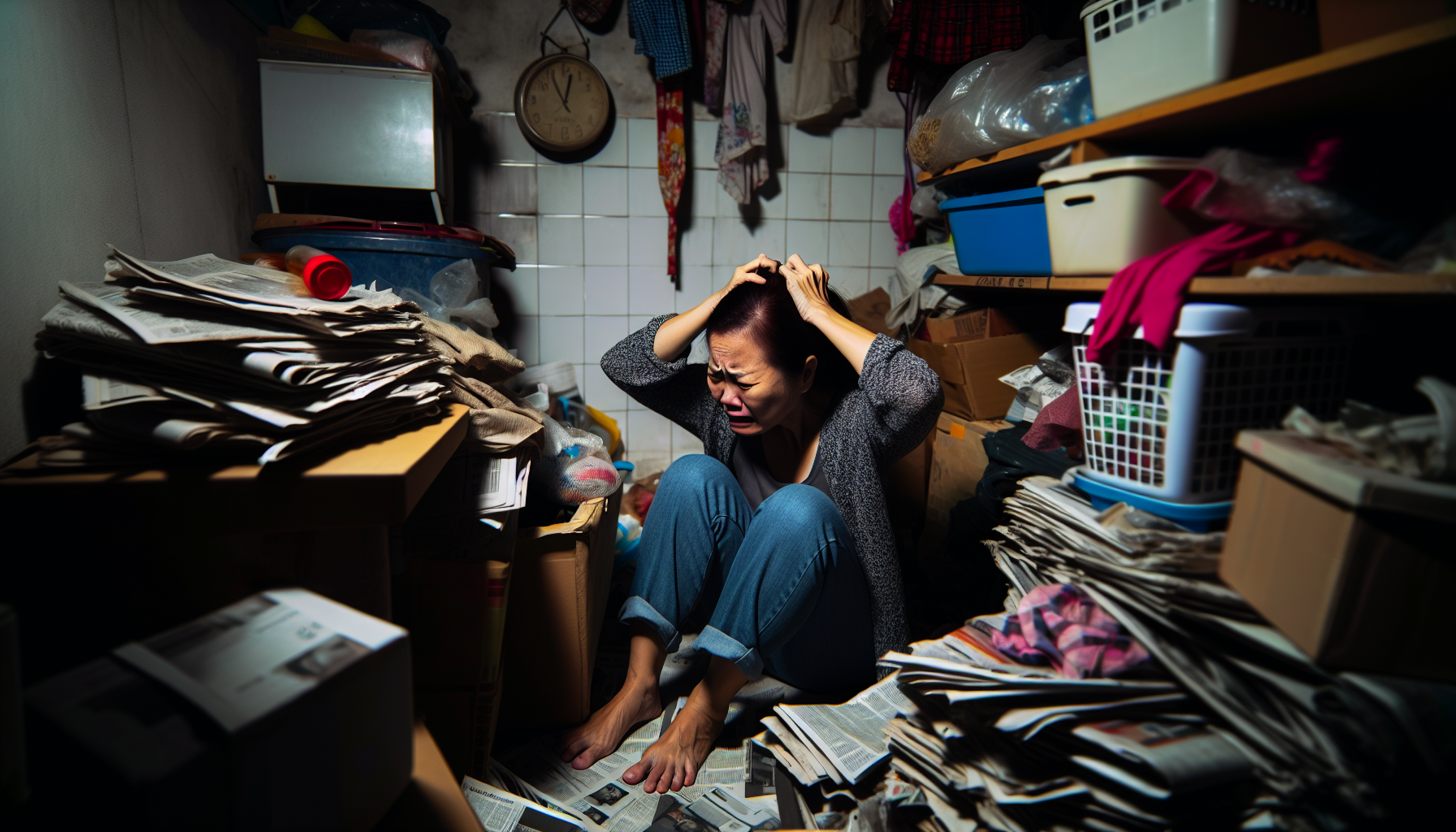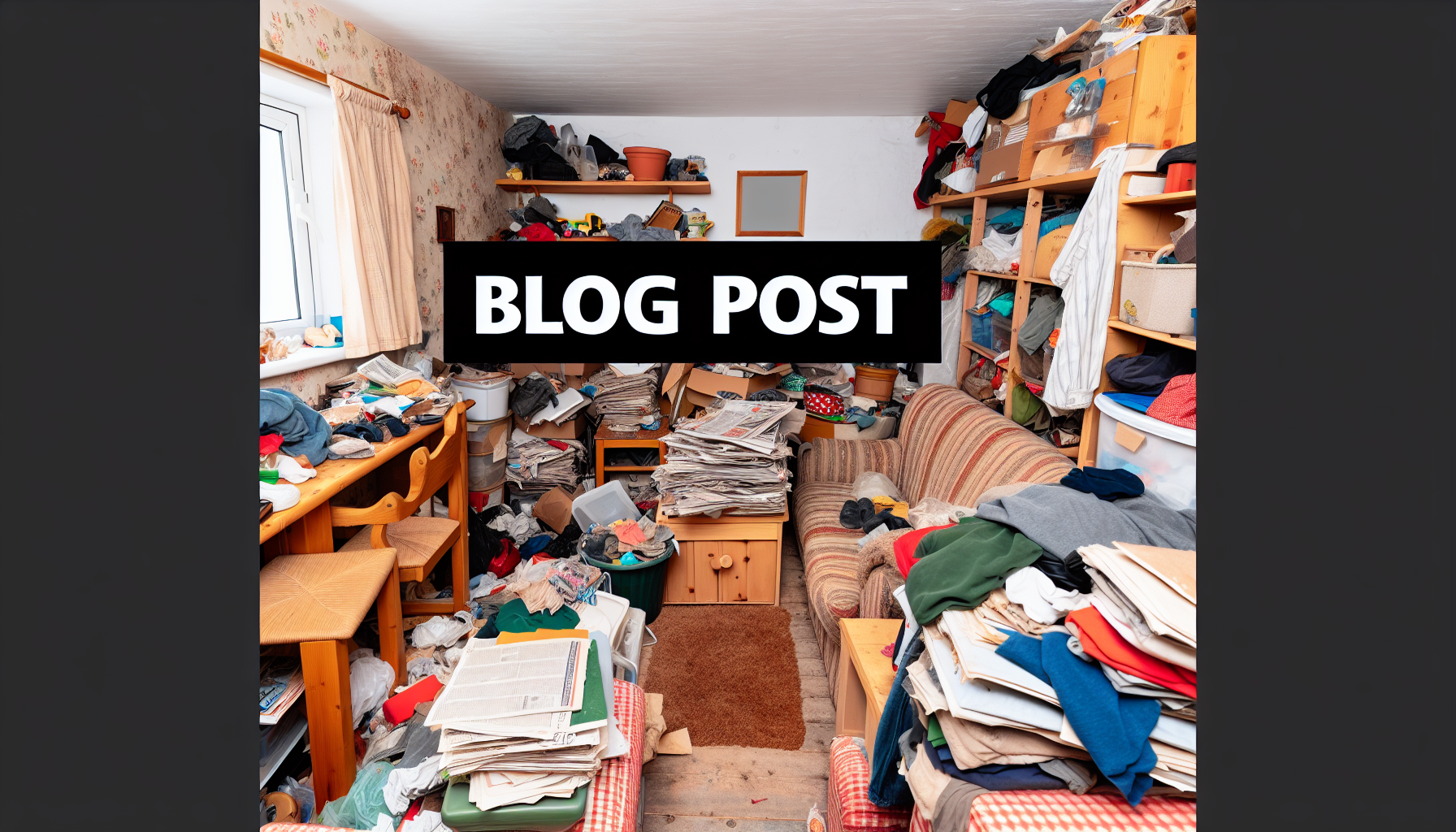Key Takeaways
-
Individuals with hoarding disorder often lack insight into their condition, struggle with self-awareness, and may attribute hoarding behaviors to external factors such as limited space, rather than recognizing their own tendencies to accumulate and retain excessive items.
-
Hoarding disorder frequently coexists with other mental health conditions such as anxiety disorders, depression, and ADHD, which complicates treatment and often precedes the recognition or diagnosis of the hoarding behaviors themselves.
-
Cognitive Behavioral Therapy (CBT), Motivational Interviewing, and Group and Family Therapy are effective treatments that target not only the hoarding behaviors but also aim to enhance self-awareness among individuals with hoarding disorder.
Understanding Hoarder’s Self-Awareness

Hoarding disorder, unlike the popular misconception, goes beyond mere collecting. It is characterized by:
-
disorganized clutter, causing distress and impairing function, a stark contrast to organized collections.
-
a disconnection between self-awareness and behavior management in people with hoarding disorder.
-
denial or lack of insight into the severity of the condition, often making it difficult to get hoarding disorder diagnosed.
As the clutter accumulates and the situation becomes overwhelming, one might expect it to act as a wake-up call. However, this is often not the case.
Factors like shame, embarrassment, and the severity of the disorder significantly shape an individual’s understanding of their hoarding behavior behind closed doors. These contributing elements build the levels of self-awareness or the lack thereof. Often, people with hoarding tendencies engage in their behaviors privately, avoiding visitors. This seclusion allows their behavior to go unchallenged, further contributing to a lack of self-awareness.
Poor Insight
Imagine not recognizing your behavior as problematic, despite its glaring impact on your life and relationships. This depicts the struggle individuals with hoarding disorder often face due to their poor insight. They might not see their excessive acquisition and retention of items as an actual problem. This lack of insight means that their symptoms align with their self-perception, leading to no subjective recognition of the disorder.
Unaware of the negative effects their behavior has on their environment and relationships, hoarders often resist intervention and show non-cooperation in therapy. Variability in insight among hoarders, coupled with their symptoms being partially ego-syntonic, can lead to a disinclination towards seeking help and less effective treatment outcomes. This poor insight is more pronounced in individuals with hoarding disorder than in those with other anxiety disorders, adding another layer of complexity to treatment and self-recognition of the issue.
Shame and Embarrassment
The powerful emotions of shame and embarrassment can influence behaviors and decisions. In hoarding disorder, these feelings can perpetuate secrecy around hoarding behaviors and discourage individuals from seeking assistance. This secrecy negatively influences the individual’s self-awareness and acknowledgement of the disorder. The fear of community judgment enhances feelings of shame and embarrassment, reinforcing secretive habits and deterring help-seeking.
Interestingly, hoarders may incorrectly attribute their difficulties to external causes, such as limited space or organizational challenges, rather than recognizing their hoarding behaviors. This misattribution is often a result of the shame and embarrassment they feel. Moreover, these feelings can create a substantial barrier to establishing trust and open communication with family members. This further inhibits recognition and resolution of the disorder, forming a vicious circle that perpetuates hoarding behaviors.
Cognitive Distortions
Cognitive distortions are often prominent in hoarding disorder. They are characterized by an overvaluation of items, trouble with decision-making, and a felt sense of responsibility to keep objects. These distortions skew the hoarder’s self-perception and obstruct self-awareness. The emotional attachment to the items, distress when considering discarding them, and specific avoidance behaviors like self-distraction and disengagement play significant roles in predicting the severity of clutter, a core aspect of hoarding disorder.
These avoidance behaviors sustain hoarding disorder over the long term by reinforcing false beliefs about the necessity of possessions. This reinforcement inhibits the collection of disconfirming evidence, further exacerbating the compulsive hoarding disorder.
Changes in brain areas that regulate anxiety and sadness correlate with the distress associated with discarding items among people with hoarding disorder. The good news is, training that focuses on accepting internal states rather than suppressing or controlling them may reduce avoidance behaviors and aid individuals with hoarding disorder.
The Impact of Co-Occurring Mental Health Conditions

Hoarding disorder is often found to be closely linked with other mental health conditions, creating a complex labyrinth of interconnected issues. This intertwining can pose additional challenges for treatment and management. It’s not uncommon for hoarding disorder to co-occur with mood and anxiety disorders, ADHD, and depression. These co-occurring conditions add layers of complexity to the clinical picture, complicating treatment and self-recognition. In fact, 75% of people with hoarding disorder also have a mood or anxiety disorder, painting a vivid picture of this intertwined complexity.
Interestingly, co-occurring mental health conditions might be the primary reason individuals affected by hoarding disorder seek treatment, potentially before the hoarding behavior is recognized. This highlights the complex and interconnected nature of mental health disorders. Therefore, addressing underlying conditions such as depression, anxiety, or OCD can be integral to preventing hoarding behaviors.
A multidisciplinary treatment team, including a mental health professional, is vital to guarantee that all service providers are knowledgeable about hoarding disorder and its co-occurring issues. This will enable a comprehensive approach to addressing the needs of individuals with hoarding disorder.
Anxiety Disorders
Hoarding disorder and anxiety disorders often walk hand in hand. Generalized Anxiety Disorder and Obsessive Compulsive Disorder are among the anxiety disorders that share similarities with hoarding disorder, and can co-occur, complicating the clinical picture. This co-existence impacts a person’s awareness and behavior related to hoarding.
Limited evidence from small and open-label studies, as acknowledged by the American Psychiatric Association, suggests challenges in medication treatment for hoarding disorder, especially when co-occurring conditions like anxiety disorders are present.
Depression
Depression is a common co-occurring condition with hoarding disorder. In fact, Major depression is the most common comorbidity with Hoarding Disorder, occurring in as many as 50% of cases. This co-occurrence can influence the difficulty in treating hoarding disorder. The presence of depression can exacerbate the hoarding behavior, leading to increased emotional distress and impairment in daily life.
A high rate of co-occurring mental health diagnoses, including depression, can make the treatment of Hoarding Disorder more challenging due to low motivation and the complexity of the individual’s emotional state. This underlines the critical importance of addressing depression in the treatment of hoarding disorder.
ADHD
ADHD-related executive dysfunction and emotional regulation difficulties contribute to hoarding behaviors and symptom severity. The inattentive subtype of ADHD is commonly found in individuals with a history of childhood ADHD, suggesting a link to hoarding disorder. Inattention, a core symptom of ADHD, is a significant predictor of the severity of hoarding, establishing a specific link between the two conditions.
Both cognitive dysfunction and emotional regulation difficulties associated with ADHD are influential in the manifestation of hoarding symptoms. Healthcare providers are encouraged to routinely assess hoarding symptoms in ADHD patients, who often have limited insight into these behaviors and their associated impairments.
Hoarding research should take into account younger adults with ADHD, as they represent a unique demographic profile with an elevated presence of hoarding symptoms.
The Role of Family and Friends in Raising Awareness

Family and friends frequently lead the fight against hoarding disorder. They play a crucial role in organizing and decluttering the living space to help individuals with hoarding disorder. However, living with someone who hoards can lead to stress, conflict, resentment, anger, or depression due to the cluttered living conditions. Friends and family dealing with a loved one’s hoarding disorder can receive support through individual therapy, family therapy, group therapy, and support groups. These different options cater to various needs and preferences to provide comprehensive support..
Dealing with a loved one who hoards requires effective communication as a key component. It involves expressing feelings in a supportive manner, using ‘I’ statements, and using the hoarder’s own terms for objects. This approach lessens the likelihood of triggering defensive reactions and improves the chances of reaching a resolution.
Intervention Strategies
Effective intervention strategies for hoarding disorder include:
-
Establishing a collaborative, multi-disciplinary community hoarding taskforce that includes mental health support. This approach is considered the best evidence-informed strategy for dealing with hoarding disorder.
-
Contacting adult protective services
-
Informing code enforcement agencies
-
Using legal aid or tenancy tribunals to prevent eviction
Engaging individuals in treatment through motivational interviewing can aid in addressing hoarding disorder, enhancing willingness to engage in treatment, and managing a harm reduction plan. A pilot study integrated motivational interviewing with practical sorting activities in the homes of older adults, aiming to reduce the severity of hoarding behavior. Initial study outcomes suggested motivational interviewing as an effective approach for older adults in hoarding disorder.
Establishing Trust and Communication
In hoarding disorder interventions, trust serves as a fundamental element. Building trust is facilitated by a motivational, harm reduction approach. Before significant changes or interventions are attempted, it’s essential to build a foundation of trust. This leads to improved cooperation and communication. Engaging in regular, non-confrontational and empathetic interactions is a key strategy in strengthening the relationship with a hoarder.
A strengths-based, incremental approach to assessment and intervention shows a recognition of the individual’s capabilities, facilitating the development of a therapeutic alliance. Peer support workers and family members are integral in building trust and supporting communication with the person affected by hoarding disorder.
Supporting Recovery
For recovery, it’s crucial that family, friends, and support agencies regularly participate in assisting adults with hoarding disorder to declutter. The aim of family therapy in hoarding disorder is not only in assisting the decluttering process but also to lessen isolation and foster a supportive treatment environment. Engaging family in the recovery journey ensures longer-term adherence to decluttering and managing a safe living space, which is especially critical for sustainable recovery.
Parents play a crucial role in addressing the hoarding behavior of their children, and family involvement is essential to prevent enabling behaviors and encourage recovery. Professionals are key in educating parents on effective management strategies for their children’s hoarding behavior to prevent reinforcement of the acquiring and saving tendencies. Setbacks are a normal part of the recovery journey, and understanding this helps patients and their support systems stay committed to the process.
Relapse prevention is a critical aspect of treatment, particularly towards the end of CBT sessions, to ensure clients have the tools to replace hoarding behaviors with healthy habits.
Treatment Options for Enhancing Self-Awareness

For hoarding disorder, the following treatment options are effective:
-
Cognitive Behavioral Therapy (CBT): This is the most well-studied and effective method for treating hoarding disorder. It is specifically designed to decrease saving, acquisition, clutter, and improve organizational and decision-making skills.
-
Motivational Interviewing: This targets motivation for behavior change and explores the patient’s uncertainty about acknowledging and changing hoarding behavior.
-
Group and Family Therapy: Treating hoarding disorder is complicated by factors such as low motivation and poor insight, so group and family therapy serve as common interventions to support individuals and their families.
Research is ongoing to find effective medications for hoarding disorder, while cognitive remediation and novel approaches like web-based CBT, home-based webcam interventions, and book-based self-help groups offer promising supplementary strategies. These treatments not only aim at treating hoarding disorder but also at enhancing self-awareness among individuals with hoarding disorder.
Cognitive Behavioral Therapy (CBT)
Cognitive-behavioral therapy (CBT) designed specifically for hoarding disorder addresses cognitive distortions and behaviors linked to experiential avoidance. It is considered the most promising clinical intervention. The CBT protocol typically involves 26 weekly sessions which may include home visits to provide context for hoarding behaviors, and can be extended for severe cases or those with additional mental health issues.
CBT utilizes cognitive therapy methods to help clients evaluate the validity of their beliefs about possessions, with exercises focusing on letting go of items, starting from less difficult to more sentimental objects. Studies have shown that 70-80% of people with hoarding disorder undergoing CBT demonstrate significant improvement after 9 to 12 months of treatment, and these improvements were largely maintained after a year.
Innovative approaches like group CBT with Internet-based clinician support have shown significant reduction in hoarding symptoms, high treatment adherence, and no dropouts, suggesting this combination can improve engagement and efficacy.
Motivational Interviewing
Building trust is a core component of motivational interviewing, which targets ambivalence and low insight in hoarding disorder, crucial for fostering motivation to change. A pilot study integrated motivational interviewing with practical sorting activities in the homes of older adults, aiming to reduce the severity of hoarding behavior. Initial study outcomes suggested motivational interviewing as an effective approach for older adults in hoarding disorder, potentially due to the lack of fear-response when discarding items.
Participants valued the ongoing motivational support from therapists, finding it a key strength of the treatment. This emphasizes the role of continuous encouragement in managing hoarding disorder. The effectiveness of motivational interviewing highlights the importance of motivation in the therapeutic process, proving it to be a powerful tool in the treatment of hoarding disorder.
Group and Family Therapy
Hoarding disorder can be effectively treated in a group psychotherapy format, with hoarding disorder treated through a therapist manual, such as the Diagnostic and Statistical Manual, specifically designed to guide group therapists in delivering treatment to individuals with hoarding disorder.
Structured support groups that incorporate CBT principles and are guided by trained peers and students have demonstrated positive results for those suffering from hoarding disorder.
Prevention and Early Intervention

Prevention strategies for hoarding disorder emphasize:
-
Harm reduction and safety over simple clutter removal
-
Developing decision-making and organizational skills early
-
Avoiding enabling behaviors
-
Motivation through realistic goals and emotional support
-
Understanding hoarding disorder and recognizing it isn’t the individual’s fault
-
Candid communication and open discussion about hoarding
These strategies play a role in preventing the escalation of hoarding patterns and are often supported by animal welfare agencies.
Destigmatizing help-seeking for hoarding behavior contributes to recovery. Getting treatment for hoarding disorder early on can prevent it from becoming a lifelong struggle and improve the chances of managing the condition successfully. Seeking help as soon as possible can make a significant difference in the long-term outcome. These prevention and early intervention strategies are essential tools in the battle against hoarding disorder, proving that prevention is indeed better than cure.
Identifying Warning Signs
Trouble discarding items and clutter build-up, starting from the teenage years and progressing into early adulthood, are early indicators of hoarding. While initially hoarding symptoms may not cause significant distress or impairment, they often become problematic later in life, around the fourth or fifth decades.
Family members are crucial in the early detection of hoarding behaviors and identifying risk factors, initiating early intervention to prevent the escalation of the disorder.
Educating Children and Adolescents
Teaching children and adolescents about hoarding is crucial since symptoms often emerge during these developmental stages and may progress to chronic hoarding disorder in adulthood. Identified hoarding behaviors in young people are connected to several adverse outcomes, such as an elevated risk of obesity, psychiatric issues, and decreased social functioning.
Tools like the Child Saving Inventory are valuable for:
-
Assessing hoarding behavior in youth
-
Enhancing the quality of research
-
Aiding in better comprehension and early intervention of hoarding issues in this age group.
Summary
Navigating the maze of hoarding disorder and its impact on self-awareness requires understanding the complexity of the disorder. Factors like poor insight, shame, embarrassment, cognitive distortions, and co-occurring mental health conditions play a significant role. The role of family and friends cannot be underestimated, as they can provide crucial support. Effective treatment options such as Cognitive Behavioral Therapy (CBT), Motivational Interviewing, and Group and Family Therapy can help manage hoarding behaviors and enhance self-awareness. Early intervention and prevention strategies, including identifying warning signs and educating children and adolescents, are vital in containing the progression of the disorder. Understanding and addressing hoarding disorder is a collaborative effort that calls for patience, empathy, and relentless resilience.
Frequently Asked Questions
Does a hoarder know they are a hoarder?
Many individuals with hoarding disorder may not see their hoarding as a problem and have little awareness of its impact on their lives or the lives of others. This can make hoarding disorders challenging to treat.
How do you make a hoarder realize they are a hoarder?
You can’t force someone to change their behavior, so be gentle when approaching the subject and avoid making threats. Instead, support them in seeking treatment and staying safe.
What is the root cause of hoarding?
The root cause of hoarding is a complex combination of altered brain connections, genetics, stress, OCD, environmental factors, altered levels of serotonin, and deeply held beliefs related to acquiring and discarding items. It’s also being studied whether childhood experiences of loss or neglect can contribute to hoarding behavior.
What distinguishes hoarding disorder from collecting?
The key distinction between hoarding disorder and collecting is that hoarding involves disorganized clutter that causes distress and impairs function, while collecting entails organized collections.
How does poor insight affect individuals with hoarding disorder?
Poor insight in hoarding disorder can lead to resistance in seeking help and treatment, as individuals may not recognize their behavior as problematic. This can hinder their recovery and quality of life.


